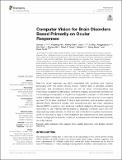| dc.contributor.author | Li, Xiaotao | |
| dc.contributor.author | Fan, Fangfang | |
| dc.contributor.author | Chen, Xuejing | |
| dc.contributor.author | Li, Juan | |
| dc.contributor.author | Ning, Li | |
| dc.contributor.author | Lin, Kangguang | |
| dc.contributor.author | Chen, Zan | |
| dc.contributor.author | Qin, Zhenyun | |
| dc.contributor.author | Yeung, Albert S. | |
| dc.contributor.author | Li, Xiaojian | |
| dc.contributor.author | Wang, Liping | |
| dc.contributor.author | So, Kwok-Fai | |
| dc.date.accessioned | 2021-09-22T18:51:27Z | |
| dc.date.available | 2021-09-22T18:51:27Z | |
| dc.date.issued | 2021-04 | |
| dc.date.submitted | 2020-07 | |
| dc.identifier.issn | 1664-2295 | |
| dc.identifier.uri | https://hdl.handle.net/1721.1/132631 | |
| dc.description.abstract | Real-time ocular responses are tightly associated with emotional and cognitive processing within the central nervous system. Patterns seen in saccades, pupillary responses, and spontaneous blinking, as well as retinal microvasculature and morphology visualized via office-based ophthalmic imaging, are potential biomarkers for the screening and evaluation of cognitive and psychiatric disorders. In this review, we outline multiple techniques in which ocular assessments may serve as a non-invasive approach for the early detections of various brain disorders, such as autism spectrum disorder (ASD), Alzheimer's disease (AD), schizophrenia (SZ), and major depressive disorder (MDD). In addition, rapid advances in artificial intelligence (AI) present a growing opportunity to use machine learning-based AI, especially computer vision (CV) with deep-learning neural networks, to shed new light on the field of cognitive neuroscience, which is most likely to lead to novel evaluations and interventions for brain disorders. Hence, we highlight the potential of using AI to evaluate brain disorders based primarily on ocular features. | en_US |
| dc.publisher | Frontiers Media SA | en_US |
| dc.relation.isversionof | https://doi.org/10.3389/fneur.2021.584270 | en_US |
| dc.rights | Creative Commons Attribution 4.0 International license | en_US |
| dc.rights.uri | https://creativecommons.org/licenses/by/4.0/ | en_US |
| dc.source | Frontiers | en_US |
| dc.title | Computer Vision for Brain Disorders Based Primarily on Ocular Responses | en_US |
| dc.type | Article | en_US |
| dc.identifier.citation | Li, Xiaotao et al. "Computer Vision for Brain Disorders Based Primarily on Ocular Responses." Frontiers in Neurology 12 (April 2021): 584270. © 2021 Li et al. | en_US |
| dc.contributor.department | Massachusetts Institute of Technology. Department of Brain and Cognitive Sciences | en_US |
| dc.relation.journal | Frontiers in Neurology | en_US |
| dc.eprint.version | Final published version | en_US |
| dc.type.uri | http://purl.org/eprint/type/JournalArticle | en_US |
| eprint.status | http://purl.org/eprint/status/PeerReviewed | en_US |
| dspace.date.submission | 2021-04-28T14:15:13Z | |
| mit.journal.volume | 12 | en_US |
| mit.license | PUBLISHER_CC | |
| mit.metadata.status | Authority Work and Publication Information Needed | en_US |
